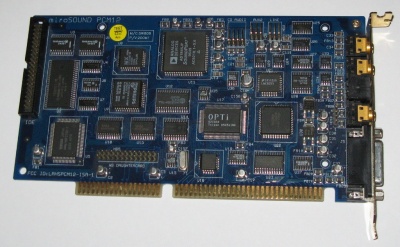Miro Sound PCM12
The miroSound PCM12 is an ISA soundcard released by miro Computer Products in 1995. The main chipset consists of an OPTI 82C924 sound controller (82C929A in earlier revisions) and a Windows Sound System 2.0 compatible codec made by Analog Devices (AD1848, Crystal CS4231a in earlier revisions). The card also features a GeneralMIDI wavetable synthesizer based on the Yamaha OPL4 chip and a 2MB ROM sound set. As a special feature, the card contains an additional microcontroller chip, the "Audio Command Interface (ACI)". On the PCM12 it serves as an additional sound mixer; on the miroSound PCM20, it also controls the built-in radio tuner.
The PCM12 has a wavetable daughterboard connector which attaches to the MPU401 (UART) port of the OPTI chip. There are four line signal inputs: AUX1, AUX2 (shared with DB), LINE-IN and CD-IN. The AUX inputs as well as the line-out and the MIDI data lines are also connected to the mini-DIN connector on the slot bracket for use with a special breakout box.
Revision E of the PCM12 has an IDE port for CDROM drives, older revisions also came with the three additional CD interfaces common at that time: Sony, Panasonic and Mitsumi. The PCM12 variants using the OPTI 82C924 are PnP-compatible, although the resources used by the card still must be configured by the initialization program that comes with the card.
DOS support
The PCM12 is configured and controlled by a single application SNDINDOS.EXE. It contains the resource configuration as well as the mixer settings. SNDINDOS expects a configuration file SOUNDCFG.INI in the directory specified by the environment variable PCM20INIT. The configuration mode can be entered by
SNDINDOS /C
The card can be switched between Sound Blaster Pro and Windows Sound System (WSS) compatibility mode, only one mode is active at a time. The MPU401 port can also be configured here. On some systems the OPTI chip may not function properly and the SBPro mode does not work (distorted sound). Then it might be necessary to post-initialize the PCM12 with the generic OPTI MAD16 driver. This driver needs a configuration file SOUNDSW.CFG in the directory defined in the environment variable SOUNDSW, the driver itself if configured by SETSOUND.EXE and loaded with SNDINIT.COM. The resources used by the PCM12 must be specified identically in both configuration programs. A typical initialization from AUTOEXEC.BAT would then look like this:
SET BLASTER=A220 I5 D1 T4 SET PCM20INIT=C:\PCM12 SET SOUNDSW=C:\MAD16 C:\PCM12\SNDINDOS.EXE C:\MAD16\SNDINIT.COM /B
The OPTI chip provides an acceptable Sound Blaster Pro compatibility, though some games (Silverball, Alien carnage and probably others) have problems with digital soundeffects on this card. These are usually distorted sound playback or SBPro detection problems. Fortunately and in contrast to other miro soundcards, the MPU401 port and the OPL4 synthesizer of the PCM12 do work in DOS.
Windows support
Drivers for Windows 3.1, Windows 9x and Windows NT4 (with some limitations) are available. The Windows 9x drivers are compatible with DirectSound and come with a mixer application which controls the ACI. The OPL4 as well as the MPU401 port are available as MIDI playback devices.
